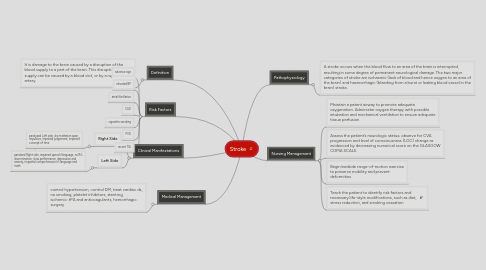Stroke
by Catherine Gonzalez

1. Definition
1.1. It is damage to the brain caused by a disruption of the blood supply to a part of the brain. This disruption of blood supply can be caused by a blood clot, or by a ruptured artery.
2. Clinical Manifestations
2.1. Right Side
2.1.1. paralyzed Left side, short attetion span, impulsive, impaired judgement, impaired concept of time
2.2. Left Side
2.2.1. paralized Right side, impaired speech/language, no R/L discrimination, slow performance, depression and anxiety, impaired comprehension r/t language and math
3. Medical Management
3.1. control hypertension, control DM, treat cardiac dx, no smoking, platelet inhibitors, stenting, ischemic: tPA and anticoagulants, hemorrhagic: surgery
4. Risk Factors
4.1. advance age
4.2. elevated BP
4.3. atrial fibrillation
4.4. CAD
4.5. cigarette smoking
4.6. PVD
4.7. recent TIA
5. Pathophysiology
5.1. A stroke occurs when the blood flow to an area of the brain is interrupted, resulting in some degree of permanent neurological damage. The two major categories of stroke are ischaemic (lack of blood and hence oxygen to an area of the brain) and haemorrhagic (bleeding from a burst or leaking blood vessel in the brain) stroke.
6. Nursing Management
6.1. Maintain a patent airway to promote adequate oxygenation. Administer oxygen therapy with possible intubation and mechanical ventilation to ensure adequate tissue perfusion
6.2. Assess the patient’s neurologic status; observe for CVA progression and level of consciousness (LOC) change as evidenced by decreasing numerical score on the GLASGOW COMA SCALE.
6.3. Begin bedside range-of-motion exercise to preserve mobility and prevent deformities
6.4. Teach the patient to identify risk factors and necessary life-style modifications, such as diet, stress reduction, and smoking cessation


